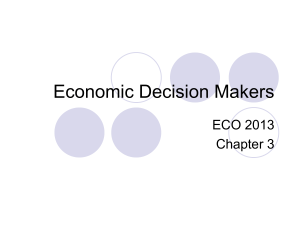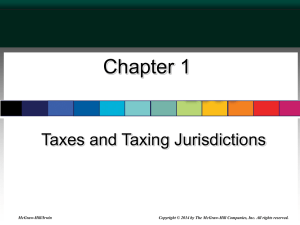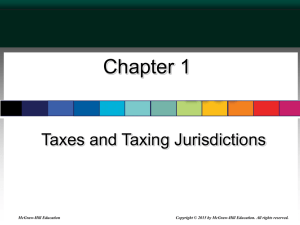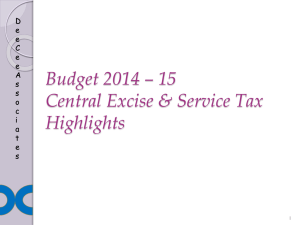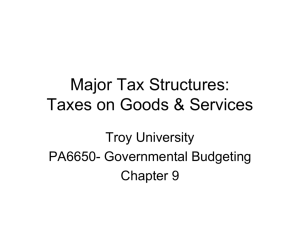Price-based measures to reduce alcohol consumption IFS Briefing Note BN138 Rachel Griffith
advertisement
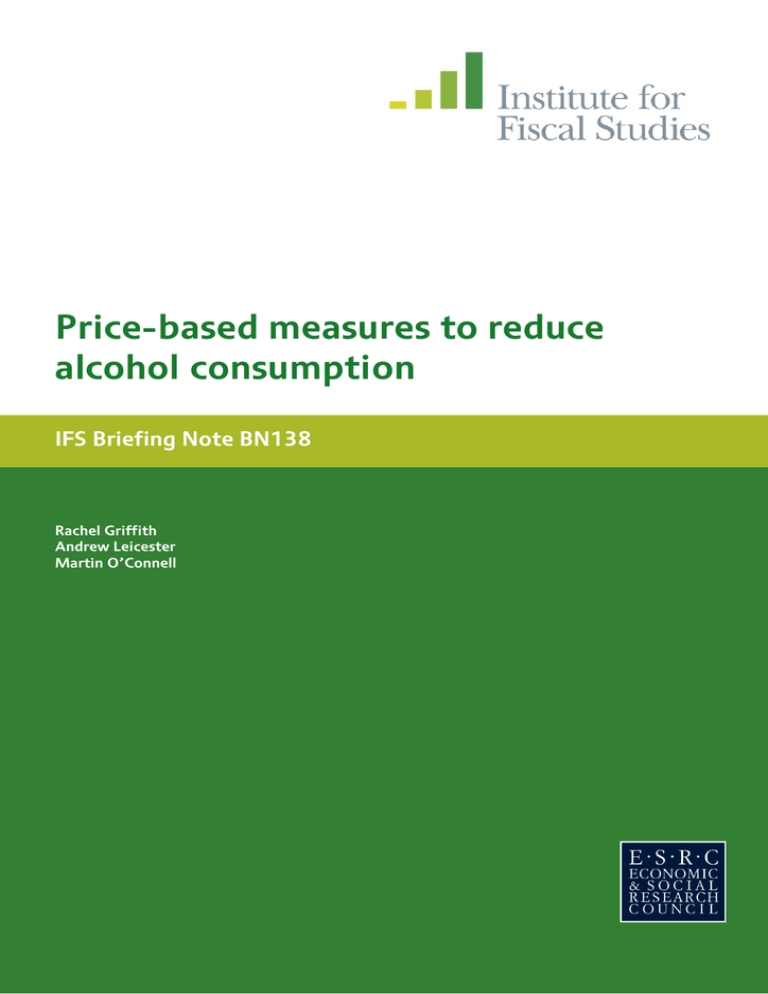
Price-based measures to reduce alcohol consumption IFS Briefing Note BN138 Rachel Griffith Andrew Leicester Martin O’Connell Price-based measures to reduce alcohol consumption* Rachel Griffith, Andrew Leicester and Martin O’Connell Institute for Fiscal Studies © The Institute for Fiscal Studies, March 2013 ISBN: 978-1-909463-06-6 Executive summary Heavy drinkers tend to buy cheaper alcohol and stronger alcohol than more moderate drinkers. Policies which raise the price of cheaper or stronger alcohol would therefore be well-targeted on those more likely to harm themselves or others as a result of their consumption. By contrast, heavy drinkers are less likely to make use of temporary quantity-based special offers on alcohol. Banning these would be a relatively poorly-targeted policy. A reformed system of alcohol excise taxes which targeted strong alcohol would be better targeted on heavy drinkers than a minimum unit price which targeted cheap alcohol. Tax reform would also see additional tax revenue go to the government, whereas minimum unit pricing would see windfalls for alcohol retailers and manufacturers. A minimum unit price of 45p per unit would in fact reduce tax revenue by around £290 million, and raise industry revenue by around £840 million. We illustrate an excise tax reform which would target heavy drinkers and would raise around £980 million in extra tax revenue and reduce industry revenue by around £340 million. Both policies would lead to a bigger proportional increase in alcohol prices for low income households than high income households. However, the extra revenues raised by a tax reform could be used to compensate poorer households if this were seen to be a problem. * We gratefully acknowledge financial support from the European Research Council (ERC) under ERC-2009-AdG grant agreement number 249529 and the Economic and Social Research Council (ESRC) under the Centre for the Microeconomic Analysis of Public Policy (CPP), grant number RES-544-28-0001. 1 © Institute for Fiscal Studies, 2013 Introduction There is widespread concern over levels of alcohol consumption in the UK. The Government’s Alcohol Strategy estimates that in 2010/11 there were 1.2 million alcohol-related hospital admissions, and that alcohol-related harm is estimated to cost society £21 billion annually.1 Recent forecasts suggest that more than 140,000 alcohol-related liver deaths will occur in the next 20 years in England and Wales.2 Governments have long intervened to try to curb alcohol consumption. Tax-based measures form a central plank of policy. Alcohol excise taxes and value added tax (VAT) together make up over half of the price of most alcoholic drinks sold off-trade (alcohol purchased in supermarkets and offlicences).3 However, the current system of excise taxes does a poor job of targeting heavy drinkers. The Home Office has recently consulted on the introduction of alternative price-based interventions in the form of a minimum unit price (where a ‘unit’ is defined as 10ml of pure alcohol) and a ban on quantity discounts for off-trade alcohol in England and Wales.4 In this briefing note we compare the effectiveness of the proposed minimum unit price and quantity discount ban to an alternative policy which reforms and significantly simplifies the structure of excise taxes levied on alcohol. We use detailed information on the off-trade alcohol purchases of a large number of households over a year to assess whether the reforms would target heavy drinkers, a group who are of particular policy concern because of the harms they cause to themselves and others by their alcohol intake. We argue that a reformed tax system could be even 1 Home Office (2012), The Government’s Alcohol Strategy, London: The Stationery Office Limited (http://www.homeoffice.gov.uk/publications/alcoholdrugs/alcohol/alcohol-strategy?view=Binary). 2 Sheron N., I. Gilmore, C. Parsons, C. Hawkey and J. Rhodes (2012), “Projections of alcohol-related deaths in England and Wales—tragic toll or potential prize?”, The Lancet, 379, 687–8 3 HM Revenue and Customs (2012), Alcohol Factsheet (March), (https://www.uktradeinfo.com/Statistics/Statistical%20Factsheets/AlcoholFactsheet03 12.xls). 4 Home Office (2012), A consultation on delivering the Government’s policies to cut alcohol fuelled crime and anti-social behaviour, London: The Stationery Office Limited (http://www.homeoffice.gov.uk/publications/about-us/consultations/alcoholconsultation/alcohol-consultation-document?view=Binary) 2 © Institute for Fiscal Studies, 2013 better targeted on this group than a minimum unit price, and that a quantity discount ban is poorly targeted. We also show that a tax reform could generate additional tax revenue for the Exchequer, whereas a minimum unit price would raise revenue for alcohol retailers and manufacturers and reduce tax revenue. If government wants to reduce alcohol consumption among heavy drinkers then it would be better advised to concentrate on reforming the excise duty system that already exists rather than to introduce a new system of minimum pricing. 1. Background There has been a long-term upward trend in alcohol intake in the UK over the last four decades. This is in contrast to many other developed countries where intake has been falling. Figure 1 shows average annual alcohol intake (measured in litres per person aged 15+) between 1970 and 2010 in the UK and in France, Germany, Italy and Spain. The different trends are clear: having begun from a much lower base, intake in the UK is now similar to that in these other countries. A similar picture emerges looking across a wider grouping: of 24 OECD countries where comparable data are available, the UK ranked 18th highest in terms of average alcohol intake in 1970, but 10th highest in 2009. Figure1. Average annual alcohol intake, 1970 to 2010 25 Annual alcohol intake (litres per person aged 15+) UK 20 France 15 Germany 10 Italy 5 Spain 1970 1972 1974 1976 1978 1980 1982 1984 1986 1988 1990 1992 1994 1996 1998 2000 2002 2004 2006 2008 2010 0 Source: OECD Health Statistics 2012 3 © Institute for Fiscal Studies, 2013 There is some evidence of a recent peak in intake: having reached 11.5 litres per person in 2004, intake fell back to 10.2 litres by 2010. However, this has reversed only a small part of the longer upward trend which came before. Average consumption in 2010 was back at 1999 levels, still around 44% higher than 1970 levels. Trends in consumption depend in part on prices. Figure 2 shows trends in real alcohol prices (that is, relative to the price of other goods and services) since 1990. Following an increase in the early 1990s, real alcohol prices overall have been largely flat, though this hides a marked divergence in price according to where alcohol is sold. Off-trade alcohol has become cheaper in real-terms whilst on-trade alcohol (sold in pubs and restaurants) has become more expensive. Real on-trade prices rose by 31% (beer) and 28% (wines and spirits) between 1990 and 2012. Real offtrade prices fell by 26% and 12% respectively. Figure 2. Real alcohol price indices, January 1990 to June 2012 140 Real index (Jan 1990=100) 130 120 110 100 90 80 70 1990 1991 1992 1993 1994 1995 1996 1997 1998 1999 2000 2001 2002 2003 2004 2005 2006 2007 2008 2009 2010 2011 2012 60 Beer (on) Wine & spirits (off) Beer (off) All alcohol Wine & spirits (on) Note: Price indices are shown relative to the all-items RPI. Sources: Calculated from ONS Retail Prices Index data 4 © Institute for Fiscal Studies, 2013 Not surprisingly consumption patterns have responded: Department for Health figures show that the proportion of alcoholic drinks consumed at home in the UK has risen.5 2. Price-based alcohol policies Current price-based policy towards alcohol is implemented through alcohol excise taxes. We first describe the structure of taxes and then discuss the other interventions proposed by the Home Office: a minimum unit price and a ban on some forms of quantity discounts. Finally, we outline a possible reform of the current system of alcohol excise duties as an alternative policy option. Our analysis in this note is based on data recording the off-trade alcohol purchases made by a representative sample of 21,542 British households over a 52-week period between November 2009 and October 2010. We observe (at the barcode level) the alcohol products which these households purchase and bring home, and match into the data details of the strength of the products (measured as alcohol by volume (ABV) percentage) and the tax which was levied on each purchase. More details of the data are provided in the Appendix. We do not have similar detailed information about household’s on-trade alcohol purchases (from pubs, restaurants and so on). Off-trade purchases make up the vast majority of the alcohol market: three in four alcohol units were purchased off-trade in 2010.6 We first provide a detailed analysis of the impact of different price-based interventions on off-trade purchases, and then discuss the implications for on-trade purchases. 2. 1 Existing policy: alcohol excise taxes Excise taxes vary by alcohol type and strength. For beer, lager, spirits and alcopops the tax is levied directly on alcohol content. For cider and wine the tax is levied per litre of product (within broad strength bands). Figure 4 shows the current structure of alcohol excise taxes measured on a perunit of alcohol basis. 5 NHS Information Centre (2012), Statistics on Alcohol: England, 2012, Health and Social Care Information Centre (https://catalogue.ic.nhs.uk/publications/publichealth/alcohol/alco-eng-2012/alco-eng-2012-rep.pdf, Table 2.7). 6 Authors' estimates using data from the 2010 Living Costs and Food Survey, which records all purchases made by a sample of households over a two week period. 5 © Institute for Fiscal Studies, 2013 Figure 4. Excise tax per unit of alcohol, by strength and type, 2012/13 Excise duty per unit (pence) 70 Wine Sparkling wine Spirits Beer Cider & perry 60 50 40 30 20 10 0 0 4 8 12 16 20 24 % ABV strength 28 32 36 40 Note: Figure assumes all cider is ‘still’ (‘sparkling’ cider attracts a different duty rate, and is levied only on champagne substitutes in pressurised bottles). Sources: Calculated from HMRC data. For spirits and alcopops, the tax per unit of alcohol is constant in strength. For beer, the tax per unit of alcohol increases with strength; strong beer attracts a higher tax rate than mid-strength beers, which in turn attract a higher tax rate than low strength beers. For wines and cider, the tax per unit varies by type and declines in strength with discrete jumps at several points. For instance, a cider with 6% ABV attracts half the excise tax per unit of alcohol of a cider with 3% ABV. The highest rates of all are levied on very low-strength wine ‘coolers’, at more than 50p per unit, whereas a typical table wine of 12.5% ABV has a duty rate of 20.3p per unit. The banding creates particular oddities for wine: moving from a wine of 5.5% ABV to 5.6% ABV sees the duty rate per unit jump from 19.5p to 45.2p. Cider typically attracts a much lower rate of duty per unit than other alcohol types, and high-strength ciders have by far the lowest duty rates per unit of any alcohol product. A cider of 7.5% ABV attracts a duty of 5.0p per unit, whereas a beer of the same strength attracts a duty of 19.5p. Overall the existing structure of excise taxes is poorly designed to target problem drinking behaviour. Most clearly, the system does not systematically tax stronger products more heavily than weaker products, whereas we demonstrate below that those drinking heavily tend to purchase stronger alcohol. 6 © Institute for Fiscal Studies, 2013 The structure of alcohol excise taxes is partly restricted by an EU Directive that sets out that the tax base for wine and cider should be the volume of liquid, whereas the base for spirits and beer is the alcohol content. 7 It is hard to think of any reasonable or defensible economic justification for such a policy. Nevertheless this acts as a legal constraint on the ability of government to implement the sort of reform to excise taxes we discuss below. However it is also currently unclear whether alternative measures, such as minimum unit pricing are legal: challenges to the policy legislated for in Scotland are already underway.8 These constraints do not therefore necessarily lend support to one form of intervention over another. Our intention here is to make clear what a better tax system might look like from an economic perspective, and to urge policy makers to win support for the necessary legal reforms to allow such policies to be implemented. Another issue when considering the use of excise taxes to influence alcohol prices is that retailers may choose not to pass taxes onto final consumer prices. Indeed, there has been particular concern about loss-leading,9 selling alcohol at a price that is lower than cost, as a way to attract people into stores. We do not have data on the cost of alcohol products, but we can look at whether products are sold for less than the tax levied on them.10 Table 1 shows that in practice we seldom observe this: fewer than 1% of off-trade alcohol units were sold at a price that was below the tax levied on them. 7 European Commission Council Directive 92/83/EEC (http://eurlex.europa.eu/LexUriServ/LexUriServ.do?uri=CELEX:31992L0083:en:HTML). 8 For example, BBC News website (2013), Legal challenge to Scotland’s minimum alcohol price plan, http://www.bbc.co.uk/news/uk-scotland-20028728. 9 See for example Bennetts, R. (2008), “Use of Alcohol as a Loss-Leader”, Institute of Alcohol Studies Occasional Paper (http://www.ias.org.uk/resources/papers/occasional/lossleading.pdf) 10 The Home Office had considered introducing this measure before announcing their intention to consult on a minimum unit price instead. See http://www.homeoffice.gov.uk/media-centre/press-releases/cheap-alcohol for details. 7 © Institute for Fiscal Studies, 2013 Table 1. Off-trade units sold for less than tax levied, by alcohol type Alcohol type Beer and lager Cider Wine Alcopops Spirits All alcohol % of units 1.2 0.0 0.5 0.0 1.4 0.9 Note: Figures are weighted to account for under-recording. Sources: Calculated from Kantar Worldpanel data, 2010. 2.2 Proposed policies i) A minimum unit price for alcohol The Home Office has recently consulted on the introduction of a 45p minimum unit price for alcohol in England and Wales. The Scottish government has gone further, legislating for a 50p rate.11 As mentioned the policy is awaiting implementation pending a legal challenge. We look at the likely impact that a 45p minimum unit price applied across Britain would have on off-trade alcohol prices.12 Figure 5 shows the proportion of units of off-trade alcohol directly affected by minimum unit pricing. 55% of alcohol units were below the minimum unit price, ranging from 84% of cider units to fewer than 1% of alcopop units across types. A minimum unit price is well targeted at increasing the relative price of cheap alcohol. It is much less well targeted at increasing the relative price of strong alcohol products. This is illustrated in Figure 6, which shows the change in the average per-unit price of alcohol by ABV strength following minimum unit pricing. The largest price increases are seen in the 4‒8% ABV range (mid- and high-strength beers and ciders), and in fortified wines or low-strength spirits of around 15% ABV. 11 Details of the legislation can be found at http://www.legislation.gov.uk/asp/2012/4/contents/enacted. 12 We assume that the 45p rate was applicable from April 2012 and that the rate is uprated each year in line with changes to alcohol excise duties and changes on the same day as excise duties change. This gives actual rates applied to the data of 38p until 29 March 2010 and 40p thereafter. 8 © Institute for Fiscal Studies, 2013 Figure 5: Proportion of units below MUP by alcohol type, 2010 % of units below minimum unit price 90 80 70 60 50 40 30 20 10 0 Cider Spirits Beer Wine Alcopops All Note: The minimum unit price applied is 38p, rising to 40p from 29/3/10. This is consistent with a 45p minimum unit price in April 2012 assuming the threshold is uprated with alcohol excise taxes. Figures are weighted to account for under-recording. Sources: Calculated from Kantar Worldpanel 2010 data. Figure 6: Change in average price per unit alcohol following MUP, by ABV Note: Minimum unit price applied is 38p, rising to 40p from 29/3/10. This is consistent with 45p minimum unit price in April 2012, assuming the threshold is up-rated with alcohol excise taxes. Figures are weighted to account for under-recording. Sources: Calculated from Kantar Worldpanel 2010 data. 9 © Institute for Fiscal Studies, 2013 ii) A ban on quantity discounts The Home Office is also consulting on the introduction of a ban on some types of quantity discounts for off-trade alcohol products. A similar policy was implemented in Scotland from October 2011. The proposed ban will apply to quantity-based special offers (such as buy one get one free, three for two and 5% off the purchase of 6 bottles of wine). It will also prohibit use of bulk discounts for products of the same brand, size and container type (for example, if a single 500ml can of brand X beer sells for £1, a 24-pack in the same store would have to sell for at least £24). However, the policy will not prohibit price based discounts (e.g. 50% off) or extra-free offers. It would also not apply to bulk discounts across container sizes of a given brand (e.g. a 2 litre bottle of brand Y cider will still be allowed to sell for less than the price of two 1 litre bottles). iii) Reform of the system of alcohol excise taxes We consider an alternative policy which would see a substantial reform and simplification of the system of excise taxes, aimed at targeting stronger alcoholic drinks. We provide evidence on one way of introducing such a policy for illustrative purposes. Clearly there is scope for much variation on this theme. In particular, we allow taxes for all types of alcohol to depend explicitly on the alcohol content, and for the rate to increase directly in line with strength. The reform is illustrated in Figure 7. The basic tax rate is higher for wines and spirits than for beers, ciders and alcopops (spirits are purchased disproportionately by heavy drinkers). Both tax rates increase as the product gets stronger. Specifically, we consider a tax schedule starting at 20p per alcohol unit for wines and spirits of 1% ABV, and 7.1p for other alcohol. Both rates increase by 0.6p per unit for each 1% increase in ABV. This is a particular example of how the excise tax system could be reformed and simplified in a quite straightforward way to better target problem drinking. We do not claim that these specific rates are economically optimal: these rates are chosen so that, under particular assumptions about how consumers and firms respond to price policies (outlined below), the reduction in total alcohol purchases is the same as achieved by a 45p minimum unit price. It may well be possible to design 10 © Institute for Fiscal Studies, 2013 even better-targeted tax reforms given more data about the drinking behaviours on which we would want to target increases in alcohol price.13 Excise duty per unit of alcohol (pence) Figure 7. Reformed excise tax structure, by ABV and type 60 Wines and spirits 50 Beers, ciders and alcopops 40 30 20 10 0 0 4 8 12 16 20 24 28 32 36 40 % ABV strength 3. Household purchasing behaviour We calculate the average number of off-trade alcohol units purchased per adult per week for each household in our data (defining adults as those aged 18+). We treat this as an indicator of how well targeted different policy reforms are: effective policies should impact more heavily on those who consume large amounts of alcohol than those who consume relatively moderately. NHS guidelines classify consumption of more than 14 units per week (women) or 21 units (men) as hazardous drinking, and more than 35 units per week (women) or 50 units (men) as harmful. We group households according to average purchase level (0–7, 7–14, 14–21, 21–35 and above 35 units per adult per week) to broadly reflect these definitions. Note again that one limitation of our analysis is that it captures only that alcohol bought off licence. 13 Tax ―equivalence‖, which would tax all units of alcohol at the same rate, is a possible option. We considered a single tax rate for all alcohol units and found that it led to roughly the same drop in average off-trade purchases for households in different intake groups. This suggests that such a policy would not be well-targeted on heavy drinkers. Details are available on request. 11 © Institute for Fiscal Studies, 2013 Table 2 describes household off-trade alcohol purchasing behaviour in each purchase group. The majority of households purchase less, on average, than the level deemed hazardous by NHS guidelines: 88% purchase fewer than 14 units of alcohol per adult per week, while 2% purchase in excess of 35 units of alcohol per adult per week.14 Table 2. Household alcohol purchases, by average purchase group Purchase group (units per adult per week) No. of households (%) Litres of beverage per adult per week (2) Units of alcohol per litre (ABV) (3) (4) % units below minimum unit price (5) % units from multi buy deal (6) 45.4 43.1 17.0 42.5 50.4 16.1 41.4 54.1 14.5 39.5 60.0 13.7 37.5 67.0 11.5 Price paid per unit (p) (1) 16,427 ≤7 units 0.2 10.5 (76%) 2,586 >7, ≤14 units 1.1 11.0 (12%) 1,103 >14, ≤21 units 1.8 12.3 (5%) 898 >21, ≤35 units 2.7 12.9 (4%) 528 >35 units 4.9 14.3 (2%) Note: Figures are weighted to account for under-recording. Sources: Calculated from HMRC data. Households that buy larger amounts of off-trade alcohol units per adult tend to buy both a higher volume of alcohol (litres of beverage, column 2) and stronger alcohols (units of alcohol per litre, column 3). A policy reform that increases the price of stronger alcohols relative to lower-strength products is therefore likely to induce larger demand responses among households that purchase greater numbers of alcohol units. Households that buy more units per adult also typically pay a lower price for each unit (column 4) and purchase a larger share of units below the minimum unit price threshold (column 5). Reforms which raise the price of cheaper products are also likely to encourage relatively large demand responses among households that tend to buy a large number of units. There is no evidence that households that have relatively high purchase levels tend to buy a higher proportion of their units on multi buy deals (column 6). In fact, it is relatively moderate purchasers who make 14 Some households may have purchased above these limits if we included their unobserved on-trade purchases. 12 © Institute for Fiscal Studies, 2013 relatively greater use of multi buy deals. This suggests that if this policy is designed to reduce alcohol purchases among those most likely to consume at harmful levels, it is not well-targeted. 4. Impact of policies A minimum unit price, or a reform to the alcohol excise tax system along the lines suggested, would target the purchasing behaviours of households that buy large numbers of units on average. A minimum unit price targets cheap alcohol, while the excise tax reform targets strong alcohol. In contrast, a ban on quantity discounts is poorly targeted, and is likely to impact more on households that purchase relatively little alcohol. Therefore, we do not consider the discount ban in further detail. We simulate the impact of the minimum unit price and excise tax reform, describe how households in different purchase groups and income bands would be affected, and how tax revenue and industry revenue would change. As noted above, to make the policies comparable, we chose the excise tax rates in the reformed system that achieve the same reduction in aggregate off-trade alcohol purchases as the minimum unit price. We assume that the policies would apply across Britain, that retailers respond to the introduction of the minimum unit price only by increasing those prices that were below the threshold up to the minimum unit price, but keep all other prices fixed, and that changes in alcohol excise taxes are passed fully onto retail prices. We also assume that consumers respond to price increases by reducing the overall amount of alcohol they purchase by 5% for every 10% increase in price – that is, the own-price elasticity of alcohol demand is -0.5 for all households. A meta-analysis of 112 studies conducted by Wagenaar et al (2009) produced -0.5 as a central estimate of the own-price elasticity of alcohol.15 We carry out our analysis at the household level. We compute the (quantity-weighted) average price per unit of alcohol paid by each household before and after each policy reform, and apply the elasticity to the price change to estimate the consumption response. 15 Wagenaar A., M. Salois and K. Komro (2009), “Effects of beverage alcohol price and tax levels on drinking: a meta-analysis of 1,003 estimates from 112 studies”, Addiction, 104, 179‒90. 13 © Institute for Fiscal Studies, 2013 4.1 Purchase response Figure 8 shows the average impact of the policy reforms on the number of units of alcohol purchased by households in each purchase group. The minimum unit price leads to a 4.1% average reduction in units purchased by households that purchase fewer than 7 units of alcohol per adult per week, rising to an 8.3% reduction for households that purchase in excess of 35 units per adult per week. This difference is driven by the fact that high purchasing households pay lower unit prices on average, with a larger fraction of units below the minimum unit price, as shown in Table 2. Figure 8. Average change in units of alcohol purchased, by policy and purchase group Units per adult per week ≤7 units >7, ≤14 units >14, ≤21 units >21, ≤35 units >35 units Average consumption change (%) 0 -1 -2 -3 -4 -5 -6 -7 -8 -9 -10 Minimum unit price Excise reform Note: The minimum unit price applied is 38p, rising to 40p from 29/3/10. This is consistent with a 45p minimum unit price in April 2012 assuming the threshold is uprated with alcohol excise taxes. Excise tax reforms are implemented at 2009/10 rates. We use the alcohol excise tax escalator to compute the 2009/10 tax rates that correspond to those in Figure 7. These are 16.9p for wines and spirits of 1% ABV and 6.09 for other alcohol, both rising by 0.5p per 1% rise in ABV, rising in line with the minimum price as above. Sources: Calculated from Kantar Worldpanel 2010 data. The reformed excise tax structure leads to average consumption changes which look, if anything, better-targeted on high purchasing households 14 © Institute for Fiscal Studies, 2013 than the minimum unit price reform. Households that buy fewer than 7 units of alcohol per adult per week reduce purchases by 2.6% on average, compared to 9.5% for those purchasing more than 35 units. These precise numbers depend on the pattern of consumer response that we assumed. It is possible that some heavy drinkers are less price sensitive than moderate drinkers. If this was the case then any price based policy would be less effective than the results here suggest. It is also possible that some heavy drinkers are more price sensitive, in which case any price based policy would be more effective. However, the comparison of how well targeted the two policies are would not be affected. 4.2 Impact across the income distribution One issue of interest is whether these reforms would impact more heavily on low-income than high-income households. Figure 9 shows the average increase in alcohol prices resulting from the reforms for relatively heavy and moderate drinkers by income group (dividing households into those purchasing more or fewer than 21 units per adult per week). Both reforms see low-income households within each purchase group face a larger average alcohol price increase than high-income households. In other words, low-income households disproportionately consume products affected by the introduction of a minimum unit price and the particular excise tax reform we consider here. The impact of the two policies across income groups looks broadly similar. The most striking difference is that, whilst the price effect of minimum unit pricing falls consistently as income rises, for the tax reform the impact on high income households is the same as the impact on middle-income households. Translating these price effects into the impact of the policies on household grocery spending gives another way to look at the impact on different income groups. Both a minimum unit price and excise tax reform lead to slightly larger proportional increases in grocery spending for low-income households than high-income households. Both policies see those with gross incomes of less than £10,000 per year spend, on average, 0.5% more on groceries, while those with gross incomes of £50,000-£60,000 per year spend, on average, 0.3% more on groceries under a minimum unit price and 0.2% more under the tax reform. 15 © Institute for Fiscal Studies, 2013 Figure 9. Percent increase in price per unit, by household income and purchase group Avwerage % chang in price per unit 25 20 15 10 5 0 £0 £9,999 £10,000 - £20,000 - £30,000 - £40,000 - £50,000 £19,999 £29,999 £39,999 £49,999 £59,999 £60,000 + Household annual gross income band MUP: Below 21 units MUP: Above 21 Tax reform: Below 21 Tax reform: Above 21 Note: The minimum unit price applied is 38p, rising to 40p from 29/3/10. This is consistent with a 45p minimum unit price in April 2012 assuming the threshold is uprated with alcohol excise taxes. Excise tax reforms are implemented at 2009/10 rates. We use the alcohol excise tax escalator to compute the 2009/10 tax rates that correspond to those in Figure 7. These are 16.9p for wines and spirits of 1% ABV and 6.09 for other alcohol, both rising by 0.5p per 1% rise in ABV, rising in line with the minimum price as above. Sources: Calculated from Kantar Worldpanel 2010 data. Both policies would therefore be mildly regressive, though the tax reform would have a slightly bigger impact on richer households than the minimum unit price. It is important to note, however, that the differences across income groups are fairly small. Further, in principle governments should not be concerned with the regressivity of individual policy reforms in isolation, but rather the distributional consequences of policy as a whole. As we note below, the tax reform would raise additional government tax revenues. If policy makers were concerned about the distributional consequences of alcohol pricing reforms then some of this revenue could be used to ameliorate these effects through other parts of the tax and benefit system. However, with minimum unit pricing no such redistribution opportunities would be available, because the revenue benefits of minimum unit pricing are enjoyed by alcohol retailers and manufacturers, unless the government chose to raise revenues or cut expenditures elsewhere. 16 © Institute for Fiscal Studies, 2013 4.3 Aggregate impact Table 3 shows the impact of the policies on the aggregate number of units of off-trade alcohol purchased, household expenditure, tax revenue and industry revenue. As discussed, the reforms are calibrated to give the same reduction in aggregate units. Table 3: Change in household expenditure, tax revenue and firm revenue, by policy Off-trade units, million Pre-reform Household Tax expenditure, revenue, £ million £ million Firm revenue, £ million 37,040 15,330 8,950 6,390 -2,400 550 -290 840 (-6.5%) (3.6%) (-3.3%) (13.2%) -2,400 640 980 -340 (-6.5%) (4.2%) (11.0%) (-5.4%) Change due to reform: Minimum unit price Excise tax reform Note: Figures are rounded to nearest 10 million. Percent changes calculated from unrounded numbers are given in parentheses. Tax revenues include excise duties and VAT. Sources: Authors’ calculations using Kantar Worldpanel data. Both policies lead to a similar increase in consumer expenditure on offtrade alcohol; the minimum unit price leads to a £550 million increase in expenditure, the excise tax reforms leads to a £640 million increase. However, how this increase in expenditure translates into government tax revenue and firm revenues differ markedly across the policies. The minimum unit price increases firm revenues by £840 million but reduces tax revenue by £340 million. The tax reform increases government revenue by £980 million and reduces firm revenue by £290 million. 5. Discussion and conclusions Both a minimum unit price and targeted reform of the alcohol excise tax system would generate substantial reductions in alcohol purchases among those households that buy a relatively high number of units of off-trade alcohol per adult per week. These households buy both cheaper and stronger units. Both policies are therefore effective at targeting households that are most likely to suffer from (or cause) alcohol-related 17 © Institute for Fiscal Studies, 2013 harms. This is in contrast to a ban on quantity-based discounts which appears to be poorly targeted on these households, and would impact more heavily on relatively moderate purchasers of alcohol. A minimum unit price will reduce government revenues from alcohol taxes, and will lead to substantial windfall gains for alcohol retailers and manufacturers. These gains could be used to fund activities that mitigate the effect of the policy, such as increased advertising or other promotional activities. In contrast, reformed excise taxes would increase government revenues, which could be used to offset any negative distributional consequences, if this is seen as an important concern, or on other policies. The precise impact of these reforms will depend on the way consumers respond. However, the general point that a minimum price will yield windfall revenues for industry, while tax reform will raise revenue for the government will hold under any pattern of consumer response. These findings suggest that a key objective for policy makers should be to pursue reforms that would allow for a more rational approach to taxing alcohol. This would require reform at the EU level. The UK government should be working actively to win support for such change. As noted earlier, our analysis focuses only on off-trade alcohol purchases. Minimum unit pricing and tax reform are likely to have different implications for the on-trade. Since on-trade prices are much higher,16 a minimum unit price would have little direct impact on alcohol sold in pubs and restaurants, whereas tax reforms would affect on-trade alcohol as well. To the extent that problem drinking takes place in the on-trade it is not clear that we would only want price reforms to affect off-trade consumption. If those who drink to excess on-trade are purchasing stronger products, then an excise tax reform along the lines discussed would still look well-targeted. The two reforms would have different effects on alcohol purchased onand off-trade. A minimum price would increase the relative attractiveness of drinking in licensed premises relative to drinking at home. Taxes which 16 The average on-trade unit in England and Wales in 2011 was around £1.41 (NHS Health Scotland (2012), Monitoring and Evaluating Scotland’s Alcohol Strategy: An update of alcohol sales and price band analyses, http://www.healthscotland.com/uploads/documents/20287MESAS%202012%20Update.pdf) 18 © Institute for Fiscal Studies, 2013 target stronger alcohol could lead to excise duty rates falling on some products, while rising on others. For example, comparing Figure 4, showing the current duty structure, and Figure 7, our reformed structure, people drinking mid-strength beers would stand to benefit through lower tax rates. Beers tend to be purchased disproportionately on-trade: whilst only one in four alcohol units overall is bought on-trade, almost half of beer units are purchased on-trade.17 So it would not necessarily be the case that a tax-based approach that targeted alcohol strength would lead to on-trade prices rising, or increase on-trade prices relative to off-trade prices. Indeed, on-trade makes up a larger share of the volume of alcohol purchased (around 36%)18 than the number of units purchased (around 25%).19 This implies that alcohol purchased on-trade is, on average, lower strength than alcohol purchased off-trade, suggesting that taxes targeting strength would raise relative off-trade prices. We are not aware of household-level data that records detailed on-trade purchases in the same way as the off-trade data used in this analysis. Such information would give a fuller account of the impact of the reforms, and assist in tailoring the tax reform to account for on-trade purchases as well. However, the key point that tax reform raises revenue for the government rather than the alcohol industry remains true regardless of these effects. There may also be other forms of problem drinking behaviour that we would like to target, such as binge drinking or under-age drinking. Given detailed data on alcohol consumption on different drinking occasions, or the drinking of young people, we could consider how different price-based proposals would impact on these sorts of behaviours, or whether other complementary policies might be more effective. Unfortunately we currently do not have such data. The cost of supporting other policies could be met through the revenue generated from the sort of tax reform discussed above. The most important unexplored question for future analysis is how the alcohol industry would respond to these policies. For example, would tax 17 Authors‖ calculations from 2010 Living Costs and Food Survey. 18 NHS Information Centre (2012), Statistics on Alcohol: England, 2012, Health and Social Care Information Centre (https://catalogue.ic.nhs.uk/publications/publichealth/alcohol/alco-eng-2012/alco-eng-2012-rep.pdf, Table 2.7). 19 Authors‖ calculations from 2010 Living Costs and Food Survey. 19 © Institute for Fiscal Studies, 2013 reforms be passed through to consumer prices? Some empirical evidence from outside the UK suggests that firms respond to tax increases by raising pricing more than one-for-one on average.20 However, it is possible that these results may not translate to the UK context, or could vary across alcohol products in ways which are as yet unknown. To our knowledge there is no work on how firms would respond to the introduction of either a minimum unit price or a quantity discount ban. 20 For example, Kenkel, D. (2005), “Are Alcohol Tax Hikes Fully Passed Through to Prices? Evidence from Alaska”, American Economic Review, 95, 273–7 and Young, D. and A. Bielińska-Kwapisz (2002), “Alcohol taxes and beverage prices”. National Tax Journal, 55, 57–73. 20 © Institute for Fiscal Studies, 2013 Appendix: Data We use data from the Kantar Worldpanel for the 52-week period 2 November 2009 to 31 October 2010. These data record off-trade purchases of alcohol made by a nationally representative sample of 21,542 British households. Households use an in-home barcode scanner to record all alcohol purchased and brought into the home. 18,756 (87%) households in the data record purchasing off-trade alcohol at least once during this period. We observe 522,125 separate purchases of alcohol. Each household is in the sample for between 84 and 365 days; the median household is observed for 301 days. We use purchase-level sampling weights to aggregate purchases to national levels. Detailed information about products purchased is captured from barcodes and till receipts. We observe the price, brand, manufacturer, retailer, package size and alcohol type for all products purchased. Strength measured as percentage alcohol by volume (ABV) is recorded for beer, cider and alcopops. For wine and spirits ABV information is only partly recorded in the data. We use information from retailer and manufacturer websites to fill in missing ABV values. Where we are unable to find the ABV of a product we apply the Office for National Statistics standard assumed alcohol content for drinks of that type.21 Information on the actual alcohol excise tax rates applicable to each purchase is taken from HM Revenue and Customs data.22 21 Goddard E. Estimating Alcohol Consumption From Survey Data: Updated Method of Converting Volumes to Units. National Statistics Methodological Series 2007, 37 (http://www.ons.gov.uk/ons/search/index.html?newquery=Estimating+alcohol+consu mption+from+survey+data%3A+updated+method+of+converting+volumes+to+units) 22 HM Revenue and Customs (2012), Alcohol Duty Bulletin (November), (https://www.uktradeinfo.com/Statistics/Tax%20and%20Duty%20Bulletins/Alcohol_1 112.xls) 21 © Institute for Fiscal Studies, 2013
